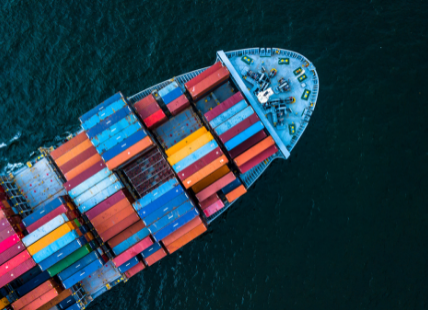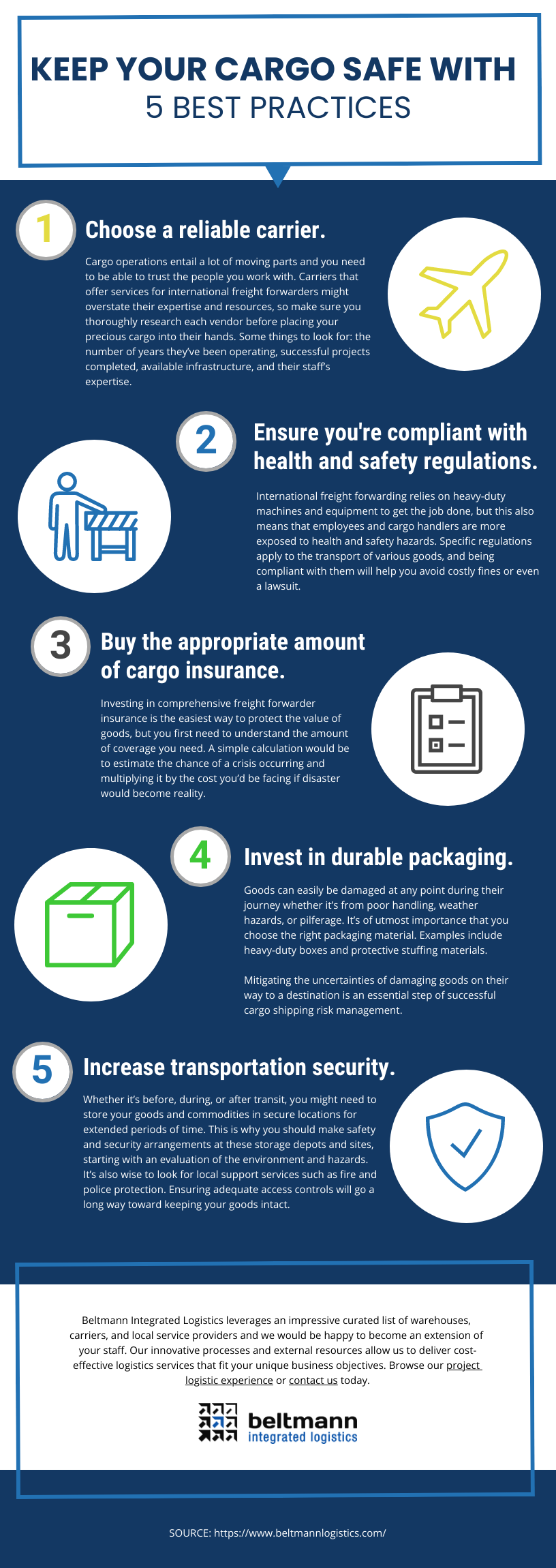
Keep Your Cargo Safe With 5 Best Practices

Extreme weather conditions, crashes, theft, documentation errors, mechanical issues, and labor disputes are just a fraction of the risks that can affect even the most well-orchestrated global shipment.
Protecting the products you’re transporting will not only safeguard your brand reputation but your bottom line as well. At Beltmann Integrated Logistics, we strive to educate customers on the most effective ways to keep their cargo out of danger and avoid significant financial losses. Here are five cargo risk management best practices you can implement right away:
1. Choose a reliable carrier.
Cargo operations entail a lot of moving parts and you need to be able to trust the people you work with. Carriers that offer services for international freight forwarders might overstate their expertise and resources, so make sure you thoroughly research each vendor before placing your precious cargo into their hands. Some things to look for: the number of years they’ve been operating, successful projects completed, available infrastructure, and their staff’s expertise.
2. Ensure you're compliant with health and safety regulations.
International freight forwarding relies on heavy-duty machines and equipment to get the job done, but this also means that employees and cargo handlers are more exposed to health and safety hazards. Specific regulations apply to the transport of various goods, and being compliant with them will help you avoid costly fines or even a lawsuit.
3. Buy the appropriate amount of cargo insurance.
Investing in comprehensive freight forwarder insurance is the easiest way to protect the value of goods, but you first need to understand the amount of coverage you need. A simple calculation would be to estimate the chance of a crisis occurring and multiplying it by the cost you’d be facing if disaster would become reality.
Here’s an example:
1% Probability of an event X $1M in Cargo Value = $10K Potential Loss
Aside from lost revenue, having coverage is also mandatory in certain countries. These nations authorize export and import operations only to carriers who can bring proof of an insurance certificate for their cargo. Make sure your logistics provider has in-house risk management professionals to help shed light on potential liabilities in the supply chain.
4. Invest in durable packaging.
Goods can easily be damaged at any point during their journey whether it’s from poor handling, weather hazards, or pilferage. It’s of utmost importance that you choose the right packaging material. Examples include heavy-duty boxes and protective stuffing materials.
Avoid spending a fortune on packaging by:
- Paying for product dimensions versus box dimensions.
- Automating time-consuming packaging tasks.
- Substituting boxes with padded envelopes for smaller products.
- Negotiating a good shipping rate, especially if you’re transporting a large volume of products on a consistent basis.
Mitigating the uncertainties of damaging goods on their way to a destination is an essential step of successful cargo shipping risk management.
5. Increase transportation security.
Whether it’s before, during, or after transit, you might need to store your goods and commodities in secure locations for extended periods of time. This is why you should make safety and security arrangements at these storage depots and sites, starting with an evaluation of the environment and hazards. It’s also wise to look for local support services such as fire and police protection. Ensuring adequate access controls will go a long way toward keeping your goods intact.
Beltmann Integrated Logistics leverages an impressive curated list of warehouses, carriers, and local service providers and we would be happy to become an extension of your staff. Our innovative processes and external resources allow us to deliver cost-effective logistics services that fit your unique business objectives. Browse our project logistic experience or contact us today.
Healthcare Logistics 101 COVID-19 has had a significant impact on healthcare practices, staff and processes. If you don’t already outsource your healthcare logistics, now may be the time to act. This article will help you better understand what healthcare logistics includes and how it can help your business. How Can Healthcare Logistics Help My Team? Flexibility to Meet Your Neesd. One of the great things about working with 3PL is that you can plick and choose from the services you need. Your 3PL team should have the experiience and ability to provide all related services, and be able to increase and decrease the services they provide for you as and when required. Next time you need to send or received PPE urgently or need to open a temporary facility due to an influx of patientss, your 3PL will be by your side to help make this happen as efficiently as possible, and ahve the flexibility to meet your needs. Save Time & Money. Your team is doing essential work. Give your internal team members the time they need to focus on their areas of expertise. A professional 3PL will be able to use its expertise to get the job done quickly and streamline processes. Working with 3PL can also help you save money. 3PLs may also benefit from preferred pricing and know how and when to negotiate. Combined Healthcare & Logistics Expertise. Choose a 3PL team with specialist healthcare experience. It is essential that you feel you can trust your 3PL team to handle, deliver, move and install high value equipment and have an understanding of your industry. A 3PL will have logistics expertise that your internal team can’t match. If you choose a 3PL with healthcare logistics experience, they will be able to combine their healthcare industry insight with their knowledge of logistics to provide optimal support and help you move towards more efficient processes. Get Started Now. We specialize in healthcare equipment logistics and medical relocations. Contact us today to learn more about how we can help. Learn more at www.beltmannlogistics.com
 Keep Your Cargo Safe with 5 Best Practices 1. Choose a reliable carrier. Cargo operations entail a lot of moving parts and you need to be able to trust the people you work with. Carriers that offer services for international freight forwarders might overstate their expertise and resources, so make sure you thoroughly research each vendor before placing your precious cargo into their hands. Some things to look for: the number of years they’ve been operating, successful project completed, available infrastructure, and their staff’s expertise. 2. Ensure you’re compliant with health and safety regulations. International freight forwarding relies on heavy-duty machines and equipment to get the job done, but this also means that employees and cargo handlers are more exposed to health and safety hazards. Specific regulations apply to the transport of various goods, and being compliant with them will help you avoid costly fines or even a lawsuit. 3. Buy the appropriate amount of cargo insurance. Investing in comprehensive freight forwarder insurance is the easiest way to protect the value of goods, but you first need to understand the amount of coverage you need. A simple calculation would be to estimate the chance of a crisis occurring and multiplying it by the cost you’d be facing if disaster would become reality. 4. Invest in durable packaging. Goods can easily be damaged at any point during their journey whether it’s from poor handling, weather hazards, or pilferage. It’s of the utmost importance that you choose the right packaging material. Examples include heavy-duty boxes and protective stuffing materials. Mitigating the uncertainties of damaging goods on their way to a destination is an essential step of successful cargo shipping risk management. 5. Increase transportation security. Whether it’s before, during, or after transit, you might need to store your goods and commodities in secure locations for extended periods of time. This is why you should make safety and security arrangements at these storage depots and sites, starting with an evaluation of the environment and hazards. It’s also wise to look for local support services such as fire and police protection. Ensuring adequate access controls will go a long way toward keeping your goods intact. Beltmann Integrated Logistics leverages an impressive curated list of warehouses, carriers, and local service providers and we would be happy to become an extension of your staff. Our innovative processes and external resources allow us to deliver cost-effective logistics services that fit your unique business objectives. Browse our project logistic experience or contact us today.
Keep Your Cargo Safe with 5 Best Practices 1. Choose a reliable carrier. Cargo operations entail a lot of moving parts and you need to be able to trust the people you work with. Carriers that offer services for international freight forwarders might overstate their expertise and resources, so make sure you thoroughly research each vendor before placing your precious cargo into their hands. Some things to look for: the number of years they’ve been operating, successful project completed, available infrastructure, and their staff’s expertise. 2. Ensure you’re compliant with health and safety regulations. International freight forwarding relies on heavy-duty machines and equipment to get the job done, but this also means that employees and cargo handlers are more exposed to health and safety hazards. Specific regulations apply to the transport of various goods, and being compliant with them will help you avoid costly fines or even a lawsuit. 3. Buy the appropriate amount of cargo insurance. Investing in comprehensive freight forwarder insurance is the easiest way to protect the value of goods, but you first need to understand the amount of coverage you need. A simple calculation would be to estimate the chance of a crisis occurring and multiplying it by the cost you’d be facing if disaster would become reality. 4. Invest in durable packaging. Goods can easily be damaged at any point during their journey whether it’s from poor handling, weather hazards, or pilferage. It’s of the utmost importance that you choose the right packaging material. Examples include heavy-duty boxes and protective stuffing materials. Mitigating the uncertainties of damaging goods on their way to a destination is an essential step of successful cargo shipping risk management. 5. Increase transportation security. Whether it’s before, during, or after transit, you might need to store your goods and commodities in secure locations for extended periods of time. This is why you should make safety and security arrangements at these storage depots and sites, starting with an evaluation of the environment and hazards. It’s also wise to look for local support services such as fire and police protection. Ensuring adequate access controls will go a long way toward keeping your goods intact. Beltmann Integrated Logistics leverages an impressive curated list of warehouses, carriers, and local service providers and we would be happy to become an extension of your staff. Our innovative processes and external resources allow us to deliver cost-effective logistics services that fit your unique business objectives. Browse our project logistic experience or contact us today.






